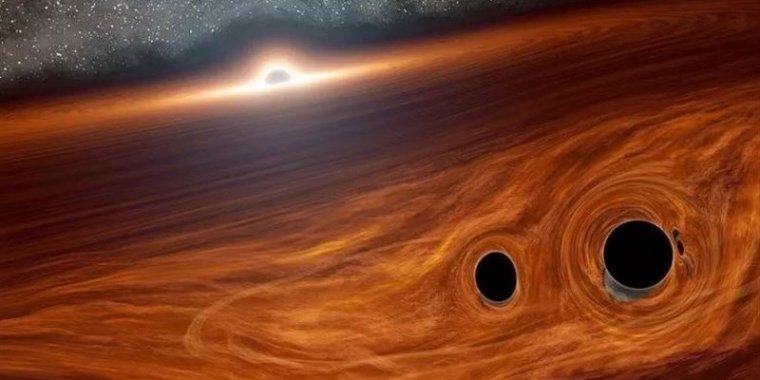| News / Science News |
Supermassive Black Holes Source of Dark Energy?
A study claims that the mysterious "dark energy", which cosmologists believe is accelerating the expansion of the universe, could arise from supermassive black holes in the hearts of galaxies.

Supermassive Black Holes Source of Dark Energy? Photo: Tasnim News Agency
If true, the connection would link two of the most mind-bending concepts in physics—black holes and dark energy—and suggest that the source of the latter has been under theorists’ noses for decades. However, some leading theorists are deeply skeptical of the idea.
“What they are proposing makes no sense to me,” says Robert Wald, a theoretical physicist at the University of Chicago who specializes in Albert Einstein’s general theory of relativity, the standard understanding of gravity.
Other theorists were more receptive to the radical claim—even if it ends up being wrong.
“I’m personally excited about it,” says astrophysicist Niayesh Afshordi of the Perimeter Institute for Theoretical Physics.
At first blush, black holes and dark energy seem to have nothing to do with each other. According to general relativity, a black hole is a pure gravitational field so strong that its own energy sustains its existence.
Such peculiar beasts are thought to emerge when massive stars collapse to an infinitesimal point, leaving just their gravitational fields behind. Supermassive black holes having millions or billions of times the mass of our Sun are believed to lurk in the hearts of galaxies.
In contrast, dark energy is a mysterious phenomenon that literally stretches space and is accelerating the expansion of the universe. Theorists think dark energy could represent some new sort of field in space, a bit like an electric field, or it could be a fundamental property of empty space itself.
So how could the two be connected? Quantum mechanics suggests that the vacuum of empty space should contain a type of energy known as vacuum energy.
This is thought to be spread throughout the universe and exert a force opposing gravity, making it a prime candidate for the identity of dark energy.
In 1966, Soviet physicist Erast Gliner showed that Einstein’s equations could also produce objects that to outside observers look and behave exactly like a black hole—yet are, in fact, giant balls of vacuum energy.
If such objects were to exist, it would mean that rather than being uniformly spread throughout space, dark energy is actually confined to specific locations: the interiors of black holes. Even bound in these particular knots, dark energy would still exert its space-stretching effect on the universe.
One consequence of this idea—that supermassive black holes are the source of dark energy—is that they would be linked to the constant stretching of space and their mass should change as the universe expands, says astrophysicist Duncan Farrah of the University of Hawaii, Manoa.
“If the volume of the universe doubles, so does the mass of the black hole,” he adds.
To test this possibility, Farrah and his colleagues studied elliptical galaxies, which contain black holes with millions or billions of times the Sun’s mass in their centers.
They focused on galaxies with little gas or dust floating around between their stars, which would provide a reservoir of material that the central black hole could feed on. Such black holes wouldn’t be expected to change much over the course of cosmic history.
Yet by analyzing the properties of ellipticals over roughly 9 billion years, the team saw that black holes in the early universe were much smaller relative to their host galaxy than those in the modern universe, indicating they had grown by a factor of seven to 10 times in mass, Farrah and colleagues reported this month.
The fact that the black holes swelled while the galaxies didn’t is the key, Farrah says. If the black holes had grown by feeding on nearby gas and dust, that material should have also generated many new stars in parts of the galaxy far from the black hole.
But if black holes were made from dark energy, they would react to changes in the universe’s size in exactly the way that researchers observed in the centers of elliptical galaxies, Farrah’s team additionally reported.
Wald is unpersuaded. He questions how an orb of pure dark energy could be stable. He also says the numbers don’t seem to add up: Dark energy is known to make up 70% of the mass-energy of the universe, whereas black holes are a mere fraction of the ordinary matter, which constitutes less than 5% of the universe.
“I don't see how it is in any way conceivable that such objects could be relevant to the observed dark energy,” he says.
Others are taking a wait-and-see attitude. “At the moment, this is an interesting possibility,” says cosmologist Geraint Lewis of the University of Sydney, but “there would have to be a lot more evidence on the table if this is even a remotely plausible source of dark energy.”
Afshordi agrees. If black holes and dark energy are linked in this way, it would likely have other visible consequences in the universe, he says. At the moment, though, he’s unsure what those would be.
Determining exactly how galaxies evolve over time is a tricky business, he adds, and there could be other mechanisms to grow black holes that the team hasn’t considered. (Tasnim News Agency)
YOU MAY ALSO LIKE





